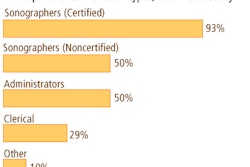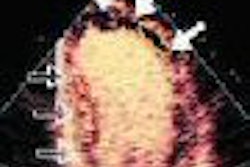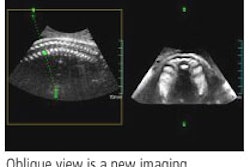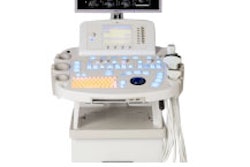ATLANTIC CITY - Contrast-enhanced ultrasound (CEUS) can precisely delineate thermal lesions from viable tissue, as well as guide and monitor radiofrequency (RF) ablation of the entire prostate, according to researchers from Thomas Jefferson University in Philadelphia. In addition, the use of cold saline infusion techniques during ablation may provide effective protection of the urethra/bladder and neurovascular bundle.
"This imaging-guided technique may provide an innovative and effective method for the treatment of prostate cancer," said Dr. Ji-Bin Liu. He discussed the university's research during a presentation at this week's Leading Edge in Diagnostic Ultrasound conference.
In phase I of a research project on monitoring prostate ablation with CEUS, the researchers sought to establish ablation parameters and optimize procedures with the contrast imaging technique. After completing phase I, the group aimed in phase II to establish a method for ablating the entire prostate, and also validate the effectiveness of urethral and neurovascular protection using cooling techniques.
Adult mongrel dogs were used in the study, which utilized an RF generator (Radionics, Burlington, MA) and an Elegra ultrasound scanner (Siemens Medical Solutions, Malvern, PA) with a 6.5EC10 probe for transrectal ultrasound. The team employed the Sonazoid contrast agent (GE Healthcare, Chalfont St. Giles, U.K.) and pulse-inversion harmonic imaging (PIHI).
In phase II of the study, a first group of dogs (4) didn't receive protective cooling of the urethra and iliac arteries, while a second group (5) had protective cooling of the urethra. A third group (4) had protective cooling of both the urethra and iliac arteries to protect neurovascular bundles (NVB), Liu said.
In the first group, the researchers noticed that periurethral and periprostatic blood flow increased dramatically during the RF ablation procedure. Thermal damage of the urethral wall and NVB areas was demonstrated on both PIHI and pathology, Liu said.
In group 2, PIHI showed urethral flow in all five dogs, and there was no visible difference in the urethral blood flow for the different infusion temperatures of the cooled saline employed in the study (0°, 4°, 8°, 12°, and 16° Celsius), Liu said. The researchers noticed thermal damage of the NBV areas on both PIHI and pathology.
"Contrast-enhanced PIHI showed normal flow of the urethral wall and the NVB area on the right side," he said.
In group 3, the urethral and iliac artery cooling clearly preserved the NVB/capsule flow, according to the researchers. Contrast-enhanced PIHI showed normal flow of the urethral wall and the NVB areas on both sides, Liu said.
After performing statistical analysis, the study team concluded that damage to the urethra was 13.64 times more likely to occur if no cooling was performed. Damage to the NVB areas was 8.75 times more likely to occur if there was no cooling of the iliac arteries, Liu said.
From the study, CEUS-guided prostate RF ablation was feasible, the researchers concluded.
"The contrast agent imaging is probably the key factor for guiding precisely to certain areas," Liu noted.
Liu acknowledged several limitations to the research, including the lack of knowledge of the changes of thermal lesions over time, and of the function of the urethra and NVB over time. Also, the transperineal approach was not feasible in the dog model, and long-term recovery animal studies are needed, he said.
By Erik L. Ridley
AuntMinnie.com staff writer
May 24, 2006
Related Reading
US combo boosts detection, characterization of perianal inflammation, January 15, 2004
Focused ultrasound shows promise as treatment for advanced renal cancer, December 16, 2003
Power Doppler US spots tumor vascularity for prostate cancer staging, April 30, 2003
Cryoablation for prostate cancer yields long-term success, December 4, 2002
Copyright © 2006 AuntMinnie.com



















